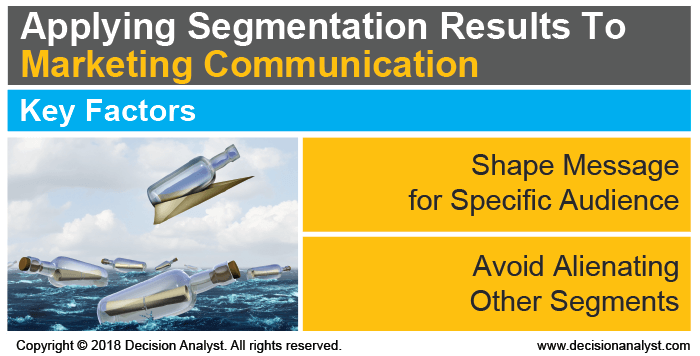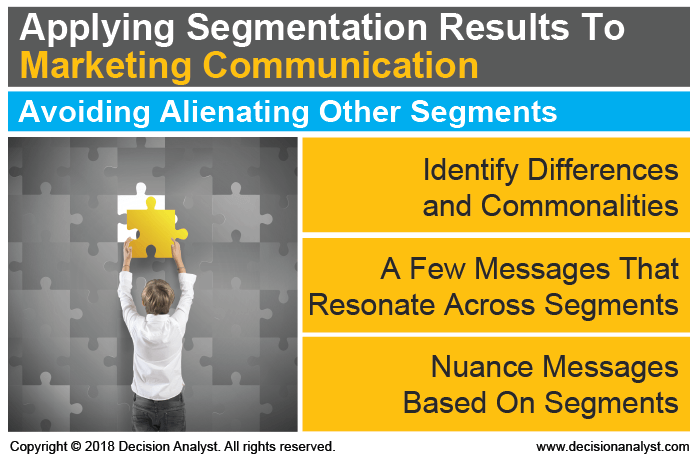Segmentation Video Series: Episode 12
Applying Segmentation Results to Marketing Communications
Segmentation: Episode 12 Transcript
Hi, I’m Felicia Rogers, Executive Vice President with Decision Analyst, here with the Segmentation Segment. Today we’re going to be looking at a couple of key factors in using segmentation to develop marketing communications. First, how do we use segmentation work to shape messages for certain audiences? And then secondly, how do we develop a winning communication strategy that will resonate with one segment without turning off others.
-
 So, let’s tackle the first one that I think is a little easier first. How do we use the learning from segmentation work to reach a specific target market? Any good segmentation study will produce a number of well-defined market segment, and each one of those segments needs to be reachable through advertising and other types of marketing, as well as distribution. We clearly have to be able to get the products to the people we’re targeting.
So, let’s tackle the first one that I think is a little easier first. How do we use the learning from segmentation work to reach a specific target market? Any good segmentation study will produce a number of well-defined market segment, and each one of those segments needs to be reachable through advertising and other types of marketing, as well as distribution. We clearly have to be able to get the products to the people we’re targeting.
Each segment should also have more, the people within should have more in common with one another than they do with people in other segments. And then each segment should really be large enough to really matter to our business or to our brands.
So once the segments are identified, we start by focusing on what the people within have in common with one another. And to shape good effective messages, we’ll focus on the things they have in common, like behaviors and attitudes, even demographics and lifestyles. So, for example, within a segment, do the people that we’ve identified: Are they more likely to be outdoorsy people? Or are they home bodies? Do they show us a lot of enthusiasm about wine? And specific types of wine? Or are they more likely to be beer drinkers? Or are they more prone to being interested in a game of golf? Or do they play darts? So these are the kinds of things we look at to help us not only target the groups that we’re looking at, but also to shape messages that will be effective for them.
So, from a targeting perspective—wine enthusiasts, for example, are more likely, probably, to visit certain types of websites and read certain types of magazines, in comparison to the websites and magazines that beer enthusiasts would be interested in. And then from an imagery perspective, the things that we might present to them in advertising—let’s take golfers—they’re probably more likely to respond positively to an ad that shows a couple of people at a driving range, for example, as opposed to a group of friends in a pool hall. So [this is] where we can start teasing things apart this way.
And then we’re also looking for specific words and ideas that along with product features and benefits that will really resonate with these people within the segment. We’re trying to make sure that we are able to communicate with them with relevant language and relevant ideas. And then, of course, all of this has to be has to be well aligned with our brand.
-
 So, here’s where things could get a little trickier. Let’s take a look at the other question. How do we target and communicate with one segment without alienating another? Certainly there will be times with segmentation work where we come up with different groups that are very different from one another. And in this case, this is going to require a lot of really heavy nuancing, maybe even separate plans or separate campaigns across different segments. Of course, this is going to be a lot of hard work, it’s going to be really tricky and can get very expensive.
So, here’s where things could get a little trickier. Let’s take a look at the other question. How do we target and communicate with one segment without alienating another? Certainly there will be times with segmentation work where we come up with different groups that are very different from one another. And in this case, this is going to require a lot of really heavy nuancing, maybe even separate plans or separate campaigns across different segments. Of course, this is going to be a lot of hard work, it’s going to be really tricky and can get very expensive.
So, we’ve got to be careful with these kinds of plans. The messages will have to be crafted very carefully, but more importantly even, we’ve got to make sure that we do a lot of thorough testing of the messages. So, we need to be sure that as we develop messages for one segment, they’re effective and they’re working as intended with that segment but without backfiring on us by turning off people in another segment.
-
 Here’s some good news though. The truth is really, with most segmentation work, we find at least overlap across segments. And what I mean by that is, we will be most likely to see that some people within segments will resonate with certain messages and share some types of lifestyles, and so then when we’re working with segmentation results what we really are looking for are not only the differences across segments but also commonalities. What do they share with one another? Ideally, what we’re looking for is to develop a few overarching messages that will resonate across segments. And so here what we say and what we show to one segment, we can be pretty confident will also be appealing and even motivational across a few other segments. At this point in this scenario, we’re able to do just some minor nuancing and some tweaking of messages and the imagery that we present, and again, be sure that it will resonate across segments.
Here’s some good news though. The truth is really, with most segmentation work, we find at least overlap across segments. And what I mean by that is, we will be most likely to see that some people within segments will resonate with certain messages and share some types of lifestyles, and so then when we’re working with segmentation results what we really are looking for are not only the differences across segments but also commonalities. What do they share with one another? Ideally, what we’re looking for is to develop a few overarching messages that will resonate across segments. And so here what we say and what we show to one segment, we can be pretty confident will also be appealing and even motivational across a few other segments. At this point in this scenario, we’re able to do just some minor nuancing and some tweaking of messages and the imagery that we present, and again, be sure that it will resonate across segments.
So to wrap this up, segmentation is a really very powerful tool and the key in effectively using it to help drive a positive outcome through our marketing communications is to understand and leverage both the differences across segments as well as the similarities and the commonalities that they share.
I want to thank you for joining us for today’s segment and invite you to be with us for our next segmentation segment where we’ll talk about applying segmentation to direct marketing.
Thank you.
Contact Decision Analyst
If you would like more information on Market Segmentation, or if you have any questions, please contact Felicia Rogers by emailing frogers@decisionanalyst.com or calling 1-817-640-6166.
Segmentation Series Videos
- Episode 01: Introduction to Segmentation
- Episode 02: Why Segmentation's Sometimes Fail
- Episode 03: Types of Segmentation
- Episode 04: Exploratory Qualitative Research
- Episode 05: Design Considerations
- Episode 06: Solution Criteria
- Episode 07: Uncovering Motivations & Key Drivers
- Episode 08: Understanding the Segments
- Episode 09: Persona Development
- Episode 10: Geomapping & Micromapping
- Episode 11: Using Segmentation in Strategy
- Episode 12: Applying Segmentation to Marketing Communication
- Episode 13: Applying Segmentation to Direct Marketing
- Episode 14: Applying Segmentation To New Product Development

